ALL CLICKABLE LINKS IN RED
The Battle of Stalingrad is considered – rightly – as one of the biggest Nazi Germany defeats and the turning points on the Eastern Front. It started in August 1942 and the last German troops surrendered on February 2, 1943. It proved once and for all that the Russians did not just depend on “mass” – as has been bandied about in many accounts – but had learned the harsh lessons of 1941 and 1942 and studiously applied them. Just like the Germans, they adopted vast sweeping manoeuvres on the flanks of their enemies. Then, the multiple prongs met behind the German lines, completely encircling them. These fast-encircling German manoeuvres had netted Russian POWs in the hundreds of thousands in 1941 and early 1942. Now, it was the Germans’ turn to be encircled as the Russians applied their well-learned “encirclement + mass” strategy. 90,000 Germans surrendered to the Russians in Feb 1943. Only 5000 came back from Russian captivity in 1955.
Stalingrad was also a brutal case of room-to-room, house-to-house, and street-by-street fighting. The German strength in armour and artillery was negated due to old-fashioned close combat between the two Armies. Though almost 90% of Stalingrad was occupied by Germans, the Russians tenaciously clung to the 10%, as it had a pier to receive fresh troops and equipment from across the Volga River. Naturally, this pier attracted considerable attention from Nazi artillery and air forces. It is necessary to understand this back story as most of the feature films we will discuss here will have some aspects of the fighting mentioned during the movie.
For those wishing to read about it, Anthony Beevor’s superb 2007 book Stalingrad is probably the best account available among the hundreds of books on the battle. For those who would like to see rather than read, here’s a superb 2001 BBC documentary free on YouTube that gives a holistic view of the events that led to the final German collapse.
Since it was an overwhelming Soviet victory where the Soviets outclassed, outmanoeuvred and outfought the Nazis, the Cold War saw to it that the West hardly made ANY films on the battle barring an odd German film. Most, if not all, of the available movies are discussed here.
The Battle of Stalingrad (1949)
Genre – War Movie
Language – Russian
Time: Two parts. Part 1: 1 hour 38 minutes. Part 2: 1 Hour, 34 minutes
Platform: YouTube (Free)
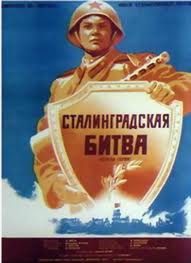
Since this is a 1949 release and since Stalin was very much alive then, the two-part film has an actor playing Stalin onscreen, discussing the overall strategy, and the commanders just nodding their heads. Naturally, failure to promote Stalin as The Great Father of Soviet Victory meant immediate death or a transfer to a concentration camp – no questions asked.
So, Stalin is onscreen every 10 – 15 minutes and giving directions. The Commanders issue the orders. The soldiers fight. Actual combat footage is woven into the black-and-white film.
Dull. Stodgy. Watch if you have nothing better to do
The film is free, in two parts, with English subtitles
Real History/ Historical Background – 4 out of 5
Script – 3 out of 5
Story – 2 out of 5
Direction – 2 out of 5
Photography – 3 out of 5
Total – 2.8 out of 5
Dogs: Do you want to live forever? (Hunde, wollt ihr ewig leben) (1959)
Genre – War Movie
Language – German
Time: 1 Hour, 33 minutes
Platform: YouTube (Free)
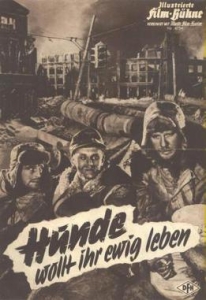
The Statement “Come on you Sons of Bitches. Do you want to live forever?” is attributed to Sergeant Daniel Daly during a WW1 battle. It is also attributed to the German Emperor Frederick the Great. So, we will never know the authentic provenance of the saying. Still, it does make for great drama and serves as a metaphor for fighting the enemy against terrible odds and dying.
The film is based on a German book with the same title. German Lieutenant Gerd Wisse is sent as a liaison officer to the Romanian Army. (Historically, the Romanians held the weakest and thinnest flank, of the Germans fighting in Stalingrad, which suffered the first heavy blows ). The Romanian officer in charge complains that his forces are thinly spread and he does not have enough reserves. There are enough indications that the Russians are planning something. The severe Russian winter sets in. The Russians attack in full force and overwhelm the sector. Wisse must retreat and reach Stalingrad and thus undergoes many adventures.
If anything, the initial desperation of the situation is shown well. But that gives way to some contrived situations that somehow take the punch away from the desperate situation of the German soldiers.
The film is free on YouTube and it is recommended to have Auto Translate on, though that does a terrible job at times
Real History/ Historical Background – 3 out of 5
Script – 4 out of 5
Story – 3 out of 5
Direction – 3 out of 5
Photography – 3 out of 5
Total – 3.2 out of 5
Stalingrad 1990
Genre – War Movie
Language – Russian
Time: Two parts. Part 1: 1 hour 30 minutes. Part 2: 1 Hour, 42 minutes
Platform: YouTube (Free)
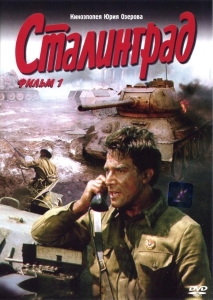
This is almost like a repeat of the 1949 version, except it is in colour. The German actors speaking German are dubbed in Russian. The Nazis are, as always, foaming-at-the-mouth devils. At the same time, the Russians are sincere patriotic folks who place Motherland overall. Boring, like the 1949 version. See if you have nothing better to do.
The film is free on YouTube with English subtitles
Real History/ Historical Background – 3 out of 5
Script – 3 out of 5
Story – 3 out of 5
Direction – 2 out of 5
Photography – 3 out of 5
Total – 2.8 out of 5
Stalingrad 1993
Genre – War Movie
Language – German
Time: 2 Hours, 17 minutes
Platform: YouTube (Free)
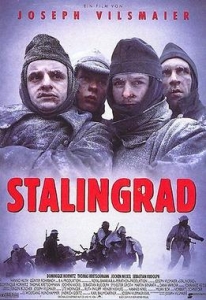
Western filmmakers do not like to deal with the Eastern Front, where Nazi Germany really lost the war (and hence the repeated bombardment by American TV channels about Normandy, Pearl Harbor and so on). So, a German colour film on Stalingrad provokes one’s curiosity. And the film does not disappoint.
German soldiers on leave in Italy, recuperating in a local hospital, are called up for action on the Eastern Front. Rollo Roehlder (Jochen Nickel) and Fritz Reiser (Dominique Horowitz) are introduced to the new platoon commander, the uptight Lieutenant Hans Witzland (Thomas Kretschmann). The veterans do not think much of their new Platoon commander. They are soon at the Eastern Front, and things go from bad to worse daily.
For disobeying orders, they are sent to a Penal Battalion where the only way out is death or making suicidal attacks. They do this in the winter against Russian tanks. They are forced to shoot a Russian boy whom they had adopted as a mascot. This affects them. The Russian attack, Operation Uranus, traps all of them, and soon, it’s every man for himself. Their objective is to reach Pitomnik airfield from where soldiers are being evacuated by transport planes.
To say more would be a crime; it’s best to watch the film. Though this is a work of fiction, the historical background is pretty accurate. (There were penal battalions on both Russian and German sides, often tasked with suicidal tasks).
The film does not go for any grand strategy and shows the fight from the ground level by front-line soldiers. Seen that way the experiences are far more harrowing than any grand back-room level stories, and how gradually everyone loses whatever shred of humanity they have. It is here that the film works, and the bitter ending shows the utter futility of the war.
The film is free on YouTube with English subtitles
Real History/ Historical Background – 4 out of 5
Script – 5 out of 5
Story – 5 out of 5
Direction – 4 out of 5
Photography – 4 out of 5
Total – 4.4 out of 5
Enemy at the Gates (2001)
Genre – War Movie
Language – English
Time: 2 Hours, 11 minutes
Platform: YouTube (Free). Amazon Prime – on rent
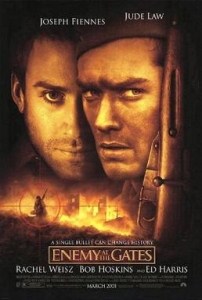
As mentioned at the beginning of this write-up, the Stalingrad battle deteriorated into a street-by-street, house-by-house, floor-by-floor and even room-by-room battle. Militarily, Stalingrad could have been bypassed but Hitler could not ignore the lure of capturing a city with Stalin’s name on it. Equally, Stalin could not ignore losing a city that bore his name. Both sides knew that victory meant the other side’s defeat would result in devastating morale.
One of the aspects of this house-by-house, room-by-room fight was the “sniper war.’ Both sides used snipers who were feared as they would fire one shot out of nowhere. One shot meant one kill. Seeing an unseen enemy kill someone in your lines was equally bad for morale. The Russians made considerable propaganda out of one of their snipers, Vasily Zaitsev, and the film has Zaitsev as a central figure. Zaitsev was not the sniper with the maximum number of kills, but he was a symbolic figure for all Soviet snipers and their successes.
Zaitsev (Jude Law) is an expert marksman who is pushed into human wave attacks and survives a mass slaughter. He picks up a rifle from a dead Russian. He shoots dead some Germans, which is noticed by a Political Commissar, Danilov (Joseph Fiennes), who also was playing dead. As a morale booster, Danilov suggests to Party Boss Nikita Khrushchev (Bob Hoskins) – later the Russian Premier from 1953-1964 – to build morale-boosting stories about Zaitsev and his kills. Russian morale goes up. So much so that the Germans bring in the Chief of the German sniper school, Major Konig (Ed Harriss), to hunt and kill Zaitsev. Soon, the cat and mouse game is on between the two, and it is a case of the more patient man with the better survival instincts who will emerge as the winner. Zaitsev also falls in love with signaller Tania (Rachel Weisz), contributing to his reluctance to go on more sniping sorties.
On its release, the film won accolades as one of the finest Hollywood films to deal with the Eastern Front. The film was an absorbing watch with major A-level stars to back the fictional story, set in the authentic Stalingrad background. However, in Russia, the critics, audience and war veterans screamed bloody murder. One even called it “Enema at the Gates” for its “distortion of history.” The distortion under discussion was the use of NKVD (Secret Police) troops to shoot any retreating Russian. Thus, the attacking Russians were either shot dead by the Germans or, if they retreated, by their side. This resulted from a famous Stalin Order no. 227, the “not-one-step-back” order, which was supposedly implemented with “blocking troops” – troops who shot down retreating Russians, as shown in this film. Some even maintain that the “NKVD blocking troops” is a WW2 Urban legend and never happened.
The most significant criticism is that the Zaitsev vs Konig’ fist fight’ never happened. Historical evidence swings in favour of this theory, but frankly, it does make for some great dramatic chilling cinema as the two snipers stalk each other in the rubble of Stalingrad. The “big background events” do not figure here at all. It is mano-y-mano and only one of them can be a winner.
Given that this is a Paramount production, money is no object, and it shows in the realistic sets, lavish special effects and authentic military gear. The “rubble of Stalingrad” was recreated in various locations near Potsdam, south of Berlin. The performances are decent but Ed Harris excels as the (fictional?) Major Konig. The last sniper duel between them is truly great cinema, worthy of a Sergio Leone climatic shootout. The romance unnecessarily drags the film – like many other Hollywood “war films.” In a brief role as Nikita Khruschev, Bob Hoskins is brilliant. Historically, Khruschev WAS present in Stalingrad as an overall Political Commissar during the crucial battles to ensure there was no political wavering by any of the commanders or soldiers.
If this had been just a sniper vs sniper movie, it would have been a unique movie without controversies and even a great war film minus all the formulaic onscreen happenings.
Trivia: The first scene where all the soldiers attack German positions and are gunned down by them, after which Zaitsev picks up a rifle and shoots dead Germans, was faithfully replicated in the Video Game, Call of Duty World at War. In the video game, Zaitsev becomes Petrenko and snipes at German soldiers whenever an artillery shell or bombs explode somewhere nearby, thus disguising the sound of his rifle – exactly like the movie. Check out the first five minutes of the in-game video
There are two free versions on YouTube – if you do not mind, hard-coded Greek and Vietnamese subtitles.
Of the two, the Vietnamese hardcoded print is far better. It is on Amazon rent too.
Real History/ Historical Background – 3 out of 5
Script – 4 out of 5
Story – 4 out of 5
Direction – 4 out of 5
Photography – 4 out of 5
Total – 3.8 out of 5
Stalingrad 2013
Genre – War Movie
Language – Russian
Time: 2 Hours, 10 minutes
Platform: Amazon Prime – rent
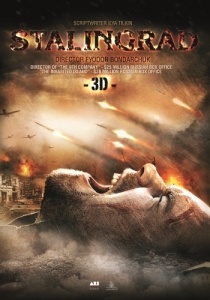
A section of Russian reconnaissance troops is tasked to hold a building and suffer repeated German attacks, slowly depleting their strength.
Great storyline but is poor in execution. Except for the ruins, there is not much here. Most dialogues are bombastic lines reminiscent of Soviet propaganda and even Hindi films. The 21st-century special effects cannot make up for the poor storyline. Somewhere in this mess, Thomas Kretschmann, plays a “decent German officer”, who takes on a Russian mistress, supplying her with food – to her family’s disgust. This tiresome plot line hopelessly stretches the unbelievable plot. He seems to be spending more time with her than fighting.
Avoidable outright Russian propaganda. Unless you are curious to see how to make a bad film
Available on Amazon Rent (but frankly save your money)
Real History/ Historical Background – 1 out of 5
Script – 2 out of 5
Story – 2 out of 5
Direction – 2 out of 5
Photography – 3 out of 5
Total – 2 out of 5
Leave a Reply
Want to join the discussion?Feel free to contribute!